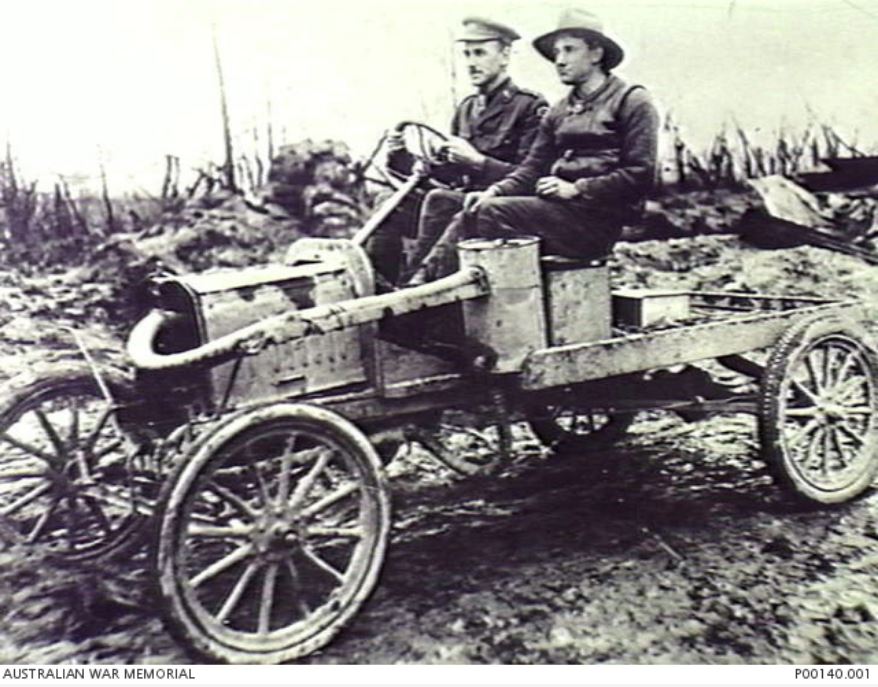1st Pioneer Battalion
From Our Contribution
 Shoulder patch | |
 Reconstructed T Model Ford without body. AWM photo P00140.001 | |
Contents
Brief History
The 1st Pioneer Battalion was an Australian infantry and light engineer unit raised for service during the First World War as part of the all volunteer Australian Imperial Force (AIF).
Formed in Egypt on 10 Mar 1916 from New South Wales volunteers, the battalion subsequently served on the Western Front in France and Belgium, having transferred to the European battlefields shortly after its establishment. Assigned to the 1st Division, the 1st Pioneer Battalion fought in most of the major battles that the AIF participated in between mid-1916 and the end of the war in November 1918. It was subsequently disbanded in early 1919.
Trained as infantrymen, the pioneers were tasked with light combat engineer functions, with a large number of its men possessing trade skills.
They met a need for troops with construction and engineering skills to assist with digging trenches, labouring, constructing strong points and undertaking battlefield clearance. At the same time, they could be pressed into the line to fight alongside regular infantry where required.
After an introduction to trench warfare around Fleurbaix the battalion was committed to the Battle of Pozieres in July 1916 where, they laid the form-up trench for the attack, before being committed to the capture of the village itself. The battalion's losses in its first battle amounted to 180 killed or wounded.
During the next two-and-a-half years, the battalion fought in most of the main battles that the Australians fought in along the Western Front. They took part in the Battle of Mouquet Farm later in 1916, and in early 1917, they were tasked with extending a light railway system towards Fremicourt as part of preparations for the Battle of Bullecourt. Later in the year, they took part in the Third Battle of Ypres, taking part in actions around the Menin Road, Polygon Wood, Broodseinde Ridge and Passchendaele. Later, around Ypres in October, the battalion worked to clear the Ypres–Zonnebeke road, which had virtually disappeared under a layer of thick mud and debris due to a prolonged artillery bombardment.
In early 1918, the Germans launched their Spring Offensive during which the 1st Pioneer Battalion, which had spent the winter around Messines, supported the 1st Division's operations around Hazebrouck in April, establishing the division's trench systems.
During the Allied Hundred Days Offensive that was launched in August 1918, which finally brought about an end to the war in late 1918, the pioneers took part in the Allied offensive around Amiens, supporting the capture of Lihons and then the exploitation beyond Proyart, losing around 80 casualties during the month. The following month they followed up the drive through the Somme until the 1st Division was withdrawn from the line in late September 1918.
Battle Honours
According to Alexander Rodger, as a result of the decision not to re-raise pioneer battalions in the interwar years, no battle honours were subsequently awarded to the 1st Pioneer Battalion – or any other First World War pioneer battalion – as there was no equivalent unit to perpetuate the honours when they were promulgated by the Australian Army in 1927[1]
Battalion Personnel
- Charles Rudolff Dumps 19 Mar 1916 - 26 Jul 1918
- Henry Melville Hardinge 16 Oct 1917 - 21 Aug 1918
Individual Honours
- 1 Victoria Cross (Pte William Edward Cox posthumous)
- Distinguished Service Order
- 1 Order of the British Empire
- 16 Military Crosses and 1 bar
- 9 Distinguished Conduct Medal
- 43 Military Medals
- 10 Meritorious Service Medal
- 34 Mentioned in Despatches and
- 8 foreign awards
Notes
Content for the history and honours sections has come from a combination of Wikipedia and the Australian War Memorial websites.
- ↑ Rodger 2003, P.91